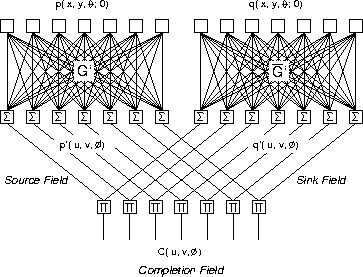
Perceptual Completion and Saliency Computations in
Areas V1 and V2 of Visual Cortex
In spite of a wealth of experimental data obtained through visual
psychophysics and electrophysiology, a comprehensive theory of
perceptual completion and saliency computations in areas V1 and V2 of
visual cortex still eludes us. It is my belief that the primary reason
for the lack of progress has been the absence of a sufficiently
abstract characterization of the underlying computational goal of
these processes. In a series of recent papers, my colleagues and I
have proposed that the goal of these processes is to compute a
distribution of closed contours consistent with position and scale
constraints derived by spatial filtering ( Williams
and Jacobs '97a, Williams and Jacobs
'97b, Thornber and Williams '96 ). The
novelty of our approach follows from the use of the mathematical
device of a particle moving with constant speed in a direction given
by a Brownian motion to characterize the probability distribution of
natural shapes. Because of the connection between Brownian motion and
diffusion processes, this device has allowed us to bridge the
conceptual gulf between the abstract goal and its concrete embodiment
in a network of neurons. The long-term objective of my research is to
develop more general neural models which can compute scale-invariant
distributions of closed contours for multiple occluded objects and
also account for unexplained phenomena such as orientation selectivity
and observed phase correlation in neural firing patterns.



